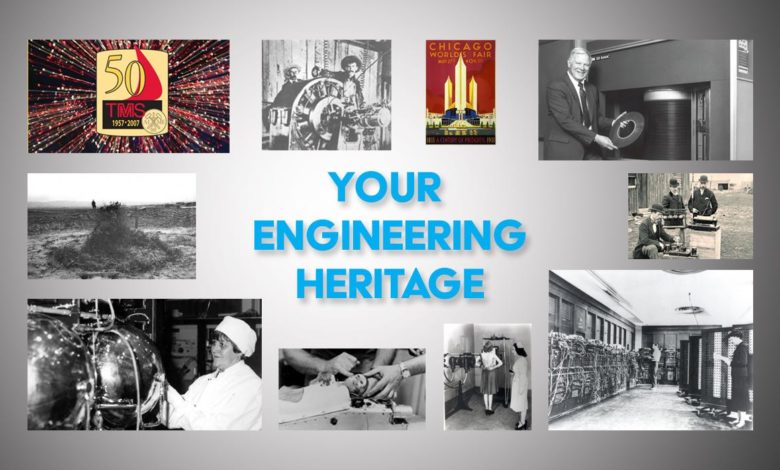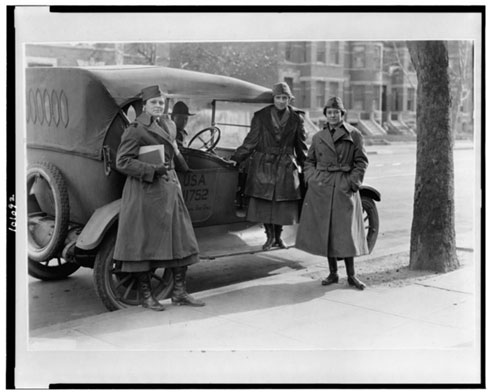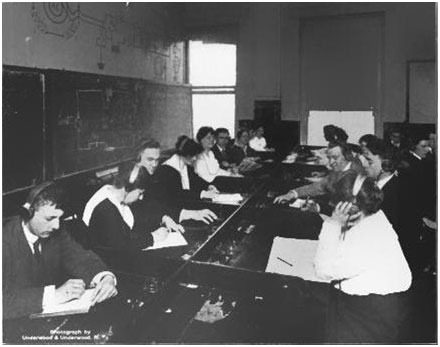
While searching for an image of radio communications in World War I, came across this image:

Preserved at the Library of Congress, it bears the unofficial title, “The Women’s Radio Corps,” dated circa 1919 and once copyrighted by the Harris & Ewing photographic studio of Washington, D.C. The women and their driver have no names; the car is identified as a government vehicle by the stenciled markings on the door. What was the Women’s Radio Corps (WRC) and who are these women?
Trying to answer those questions demonstrates of the power of searching the constantly growing wealth of information on the Internet. A search for images, say, leads to links to related images and information through linked websites. Searching for more references to a name brings forth once obscure newspaper references, thanks to Google’s scanning initiative. Google’s links to other digital newspaper repositories leads to an equally rich mine of public domain publications. Broader subject searches give us well documented articles on Wikipedia that help explain the causes and consequences of this little known organization.
Let’s begin with a search of Google for the “Women’s Radio Corps.” This generates “about 33,600” results, the vast majority of which are efforts to profit from the public domain status of this image. In fact, after 13 pages, Google omits “some [33,472] entries very similar to the 128 already displayed.” On the first page of results, however, we find an entrée in the fourth listing. The Georgetown County Digital Library, operating out of South Carolina, features another photo given the same title. We see a different woman, very tall, slim, and bemused in her WRC uniform. She leans slightly, like the Tower of Pisa, eyes rolling skyward; two cars are parked behind her in the shade of tall trees. This is Belle Baruch, the daughter of Bernard Baruch, Wall Street financier and advisor to seven presidents. Her status explains the web presence, for the Baruchs were the 20th century plantation owners of Hobcaw Barony in Georgetown County. Belle’s foundation still runs Hobcaw and provided the family photos to the Digital Library project. More searches of the Library’s collection reveal that she graduated from the Misses Rayson’s School in New York City in 1917. With the end of school and the commitment of the U.S. to fight in the Great War, Belle joined the American Red Cross.
Then a different photo offers another lead: a “Radio Class at New York City’s YMCA 1918.” Here is Belle, third from right, with fifteen other young women, a matronly Mrs. Herbert (Edna) Sumner Owen, and a handsome young male instructor in a classroom full of batteries, condensers, tuning coils, and other wireless equipment. Belle appears again in what must have been a chilly classroom, wearing her fur-trimmed coat and copying code with thirteen other young women, under the eyes of the instructor and Mrs. Owen.
Now we have some names to search. Google Books gives us substantial excerpts from Mary E. Miller’s Baroness of Hobcaw, a biography of Belle Baruch. Biographies of her father, Bernard, who ran the Committee on War Materials and the War Industries Board during World War I for a dollar a year, reveal little about his daughter. Miller relates, however, that Belle sought something more challenging than the Red Cross and found it in the WRC. Belle’s experience later led her and her girlfriend, Evangeline Johnson, to persuade the ailing former president Woodrow Wilson to broadcast a final appeal on behalf of the League of Nations on the eve of Armistice, or Veteran’s, Day in 1923. At some point she also flirted with RCA president David Sarnoff by trading messages and jokes in Morse code.
Why would Belle know Sarnoff? Perhaps through her father, but the more likely connection appears in the St. Petersburg Evening Independent. A defunct newspaper digitized in Google’s New Archive, its informative article on the WRC appeared on 9 January 1919 and was syndicated in other papers. “Here’s a New Career for Girls; Women’s Radio Corps Offers It” explains that Owen and her advisory council were recruiting new women to join the transition to commercial employment for the female wireless operators. The council members listed indicate Owen’s considerable powers of persuasion: Gano Dunn, past president of the American Institute of Electrical Engineers; Alfred Goldsmith, co-founder of the Institute of Radio Engineers; Edward J. Nally, vice president and general manager of the Marconi Wireless Telegraph Company of America; and Columbia University professor Michael Pupin, then president of the IRE. All of them knew Sarnoff through IRE or American Marconi associations, and all but Pupin would help lead the Radio Corporation of America (RCA), when it was formed out of American Marconi later that year. It is not difficult to imagine that Sarnoff, then reporting to Nally as commercial manager, was delegated responsibility to supply the WRC with training equipment.
Why would such a small group attract such endorsements? The American Marconi branch was a subsidiary of the parent company in England, and its business policies irritated American military, especially naval, officials, who sought government control of the wireless industry. By contributing to the training of women radio operators, American Marconi could demonstrate its patriotism and offset the negative press from the U.S. Navy and government hearings.
Who was Owen and what did the Corps do? Thanks not only to Google News and Books, but also to the Library of Congress’s Historic American Newspapers Project, we can learn about the pioneer feminist who organized the WRC. Born Erna von Rodenstein, Owen was the wife of a Mayflower descendant and businessman in Utah, where she campaigned against polygamy before they moved east. Through Wikipedia and Thomas White’s United States Early Radio History website, we know that women had been working with wireless technology since at least 1904, when passenger Medora Newell sent a message from R.M.S. Slavonia. Women operated stations in San Jose and New York City in 1910, and by 1913–the first year in which the federal government kept track–over 30 women had shipboard wireless licenses. These figures represented little more than novelty, however, since the number of male operators dwarfed them 40 to one. Women comprised a fraction of the 1,322 licensees; four years later there were over 6,000 licensed amateurs, and there is no reason to assume that the gender ratio changed significantly.
We don’t know why Owen took up this particular hobby horse, but she was thoughtful enough to understand three things. First, that radio as a technology and industry was evolving and growing rapidly; second, that women could increase their earning power in an industry dependent on skilled workers; and third, that the best way to gain support for increased female access and participation was to militarize women’s involvement. Owen got the program started at Hunter College for women, which was looking to do its part in the war preparedness effort. As chairman of the wireless division of the National League for Woman’s Service, then, she approached the U.S. Navy just six days after the U.S. entered the war in April 1917 with an offer to provide 500 licensed female wireless operators in six months. To that end Owen campaigned tirelessly to add recruits, lecturing up to 200 young women at once in lectures in New York and Washington, D.C., on the “many wonderful opportunities” brought by the occasion of the “great world war. . . . [I]t is your duty to prepare yourselves in order that you may set men free, that they may go to the front and fight for you and yours.”
Owen was not unique in her ability to fuse feminist ambition with patriotism, or in applying it to radio. Mrs. Alexander MacKenzie, whose husband had died in 1915 as president of the Elmira College for women, joined the New York State Woman Suffrage Party and decamped for Yonkers. That summer she used her son’s wireless station to regularly tap out “Votes for women” to other operators, and campaigned around the clock over the air on Election Day in November. Two other upper-class women, Josephine Craw and Mrs. M. E. Hamilton, organized a wireless telegraph camp for perhaps fifteen young women on Craw’s estate in Rowayton, Connecticut, in the summer of 1916, earning recognition in Literary Digest for their contribution to national preparedness.
The following year, before Congress voted for war on the Allied Powers, some 75 women responded to Owen’s recruiting, of which a third were accepted initially for the six-month course. Three more groups followed at two week intervals. The cost was eighteen dollars, about half the price of a men’s course at the YMCA. Owens set the price in recognition of the lower earning power of the working girls she spoke of, but the photos and articles indicate that the students hailed from the upper-class precincts of the Northeastern U.S. At Hunter College, they met four evenings a week for ten hours to learn the intricacies of transmission in a laboratory containing “apparatus and appliances . . . up-to-the-minute and complete in every detail.” The source of this equipment, according to The New York Times, was “Edward J. Nally . . . and David Sarnoff, general commercial manager of the Marconi Company, [who] came to the front.” They also apparently provided the young male instructor, Otto Redfern, an employee recently transferred from the Great Lakes Marconi station in Duluth.
By that summer, 125 women had enrolled, a fact noted by the chief signal officer of the Army Signal Corps in a congratulatory letter to Owen in July. In the fall she became director of the Women’s Division of the National Amateur Wireless Association in order to expand the scale of her women’s training. Now women could not only train at American Marconi’s school, but across the country they could take a correspondence course conducted by Elmer E. Bucher, who taught American Marconi’s own classes and published a series of best-selling books for its Wireless Press. Beyond learning the theory and operation of the equipment–and pledging allegiance to their nation–women learned to send, receive, and transcribe Morse code.

They also put up with the standard prejudices of the era about women in the professions. The acme of this attitude was expressed by the founder of wireless telegraphy, Guglielmo Marconi, who received a visit from 30 students on July 4 at his eleventh-floor suite in the Ritz Carlton Hotel. One imagines that Mrs. Owens, on learning that Marconi was too busy to travel to Hunter College, took the class to him. There followed the patronizing reportage of the era and remarks by Marconi to the point that women were employable because their voices were “pleasanter” than men’s and they could be good shipboard operators if they ignored the men courting them, repressed their “excitable emotional tendencies,” and did not disclose to friends the confidential nature of the messages they handled.
The few and, one hopes, the proud, having survived the patronizing environment and challenging technology, completed their training, and took their operator license exams. And then? We know from Belle Baruch’s photo captions that she earned her first-grade commercial license and was assigned to the U. S. Signal Corps as a junior inspector of radio equipment. In that capacity she taught Morse code to aviators at two training camps on Long Island. Others also inspected equipment or worked in the Signal Corps’ Radio Research and Development Section. There is no word that any actually operated a radio telegraph station for the armed forces or wireless industry.
Curiously, the WRC did not demobilize with the Armistice in November 1918. By then some of its members had moved to Washington, D.C., where they joined many other single women in filling in for male workers in government bureaucracies, setting up a boarding house at 2834 14th Street in the Columbia Heights neighborhood. As civilian staff attached to the U.S. Signal Corps, they wore uniforms and insignia inspired by those of the British and Romanian armies and the Royal Flying Corps. Two months later it had only 21 members and then disappears from the online historical record.
As to the legacy of the WRC, twelve women organized the Young Ladies’ Radio League in 1939, which remains active today. During the Second World War, technically capable women were in great demand. The Army Air Corps Force competed with the Army Airways Communication System to fill hundreds of positions, not only as code instructors but as station and control tower operators. To be sure they endured the old and new prejudices: that they would become hysterical in a crisis, their voices would be hard to hear by pilots, or that they would distract the men in training. Those attitudes have substantially eroded, but women still held only about fifteen percent of the 682,000 U.S. wireless licenses in 2004, a figure that has not changed significantly since.
Returning to the photo that began this search, who were those three women of the Women’s Radio Corps? Thanks to the St. Petersburg Independents grainy crop of the original image, we know now that Elizabeth Baker is on the left. Given the culture of the WRC, it’s entirely possible that she is Betty, the daughter of the Secretary of War Newton and Mrs. Elizabeth Baker, who all flew on one of the first airliners out of D.C. in September 1919. The others remain a mystery until, one day, family genealogists uncover what their wireless ancestors did during the Great War.
“Woman’s Work in Wireless,” The Wireless Age 4, June 1917, p. 680-3.
“The Wireless Class for Women,” The Wireless Age 5, January 1918, p. 339-41.
Alexander B. Magoun, Ph.D., is outreach historian at the IEEE History Center. Visit the IEEE History Center’s Web page at: http://www.ieee.org/about/history_center/index.html. For more articles by History Center staff, visit their publications page at: http://ethw.org/Archives:Books_and_Archival_Publications or visit the IEEE History Center’s Web page at: http://www.ieee.org/about/history_center/index.html. The IEEE History Center is partially funded by donations to the History Fund of the IEEE Foundation.






